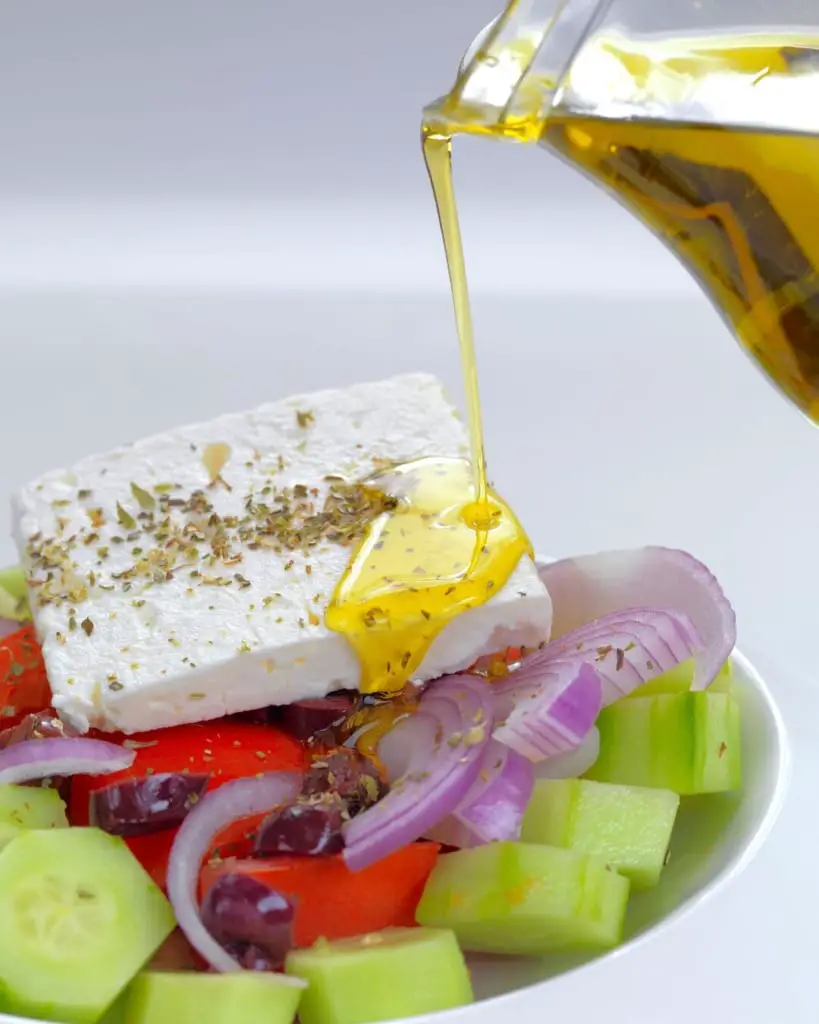Ever wondered what is in a Greek salad? This classic Mediterranean dish is not just a feast for the eyes but also a delight for the palate, featuring a simple yet vibrant combination of ingredients.
Though simple in its composition, the secrets to capturing the essence of the perfect Greek salad lie in the finer details. From the proper way to serve feta cheese to the absence of vinegar in the dressing, it’s time to unveil the true art of Greek salad making.
What is in a Greek Salad?
When it comes to authentic Greek cuisine, a refreshing traditional Greek salad, known as Horiatiki, is the gold standard. In this section, we will uncover the authentic elements of a Greek salad and what sets it apart from its imitations.
The Core Ingredients
A true Greek salad hinges on fresh, quality produce. The essentials include ripe tomatoes cut into chunks, crisp cucumbers, sharp red onions, robust Kalamata olives, and a generous slab of briny feta cheese.
| Ingredient | Role |
|---|---|
| Ripe tomatoes | The base for the salad’s juicy and flavorful profile |
| Crisp cucumbers | Provide a fresh, crunchy texture to the dish |
| Sharp red onions | Add a piquant layer of flavor |
| Kalamata olives | Contribute a robust taste and meaty texture |
| Feta cheese | Offers a creamy, salty contrast to other elements in the salad |
| Olive oil and oregano | Complement and enhance natural flavors while keeping it simple |
Remember: The key to an outstanding Greek salad lies in the quality of its tomatoes. By selecting vine-ripe tomatoes and allowing their flavors to develop properly, you can craft a truly authentic and delicious Mediterranean delight.
Unlike other variations, a traditional Greek salad does not use vinegar. Instead, the flavors are drawn out naturally from these core ingredients, particularly the tomatoes, which release their juices when seasoned with a bit of sea salt.
Related Article: While exploring what is in a Greek salad, you may be wondering about other popular salads. Discover the classic components of a Cobb salad in our article on “What’s in a Cobb Salad.”
Key Distinctions: What Sets It Apart?
What sets a traditional Greek salad apart is its authenticity in preparation and presentation. Instead of mixing the feta cheese into the salad, a single thick slice or a large chunk is placed on top, preserving its texture and flavor.
The dressing is simple yet effective—good-quality olive oil and a sprinkle of dried oregano are all that’s used, allowing the natural flavors of the vegetables to shine through.
This minimalist approach emphasizes the freshness and quality of the ingredients, proving that simplicity often leads to perfection in taste. The result is a vibrant dish that celebrates the very essence of Greek culinary tradition, offering a delicious experience with every bite.
Preparing Your Greek Salad: A Step-by-Step Guide
When it comes to making a Greek salad, the key lies in the freshness of your ingredients and the mastery of a few simple techniques. Follow these easy steps to bring the delights of a traditional Greek salad recipe to your table.
- Select ripe tomatoes, ideally vine-ripened and in season, to serve as the foundation of your salad.
- Wash, dry, and cut the tomatoes into irregularly shaped chunks, ensuring they vary in size to create a more appealing texture. As you cut, make sure any excess juices are retained in the serving bowl.
- Sprinkle sea salt over the tomato chunks and allow them to rest for about 15 to 20 minutes. This step is crucial in extracting the natural tomato juices that form the base of your salad dressing.
- While the tomatoes rest, wash and dry the cucumbers, red onions, and Kalamata olives. Cut cucumbers into thick slices and red onions into thin rings or half-moons. Leave the olives whole or slice them, depending on your preference.
- Add the cucumbers, onions, and olives to the bowl of tomatoes, gently tossing the ingredients together.
- Drizzle good-quality extra virgin olive oil over the mixture. The oil should be sufficient to cover the surface of the salad but not drench the vegetables.
- Season the salad with freshly ground black pepper and dried oregano.
- Finally, complete your Mediterranean salad preparation by adding a slab or a slice of feta cheese on top of the vegetable mix. Avoid crumbling the cheese to maintain its authentic texture and appearance.
And there you have it: a delicious, traditional Greek salad right before your eyes, bursting with the flavors of Mediterranean cuisine. Just remember to let each step work its magic to extract the ingredients’ natural flavors and guarantee a harmonious and delightful dish that will be enjoyed by all.
Related Article: Greek salad is a fantastic option to pair with chicken. If you’re looking for more great salad pairing ideas, check out our article on “Salad That Goes With Chicken” to discover other delicious combinations.
Choosing Your Greek Salad Dressing
While the classic Greek salad dressing forgoes vinegar, variations sometimes include it for convenience or to cater to fast-paced food service. The traditional dressing is exceptionally straightforward, combining high-quality extra virgin olive oil with salt, pepper, and oregano, respecting the simplicity and natural flavors of the quintessential Greek salad.
For those who wish to explore their options and experiment with their own Mediterranean salad seasoning, we have compiled a simple table detailing different combinations, which can be tailored to suit personal preferences:
| Dressing Style | Oil | Vinegar | Seasonings |
|---|---|---|---|
| Traditional Greek | Extra Virgin Olive Oil | None | Salt, Pepper, and Oregano |
| Modern Twist | Extra Virgin Olive Oil | Red Wine Vinegar | Salt, Pepper, Oregano, and Crushed Garlic |
| Fruity & Refreshing | Extra Virgin Olive Oil | Lemon Juice | Salt, Pepper, Oregano, and Grated Lemon Zest |
| Bold & Robust | Extra Virgin Olive Oil | Balsamic Vinegar | Salt, Pepper, Oregano, Crushed Garlic, and Chopped Fresh Basil |
Whether choosing a traditional Greek salad oil and vinegar blend or experimenting with a new combination, always prioritize high-quality ingredients and pay homage to the core traits that define an authentic Greek salad.
The Correct Way to Serve Feta Cheese in a Greek Salad
Although it may seem like a minor detail, the way you serve feta cheese in a Greek salad can greatly impact its presentation, taste, and the overall experience of this beloved Mediterranean dish. In this section, we dive into the reasons behind the Greek salad cheese tradition and guide you on how to properly serve feta in Greek salad to maximize its gustatory potential.
A Singleton or a Slab: Presenting the Cheese
When it comes to feta cheese presentation, the tradition is to place a substantial slab or a single slice on top of the salad, not mixed or crumbled within. Doing so not only enhances the dish’s visual appeal but also offers a beautiful contrast between the feta’s creamy white hue and the salad’s vibrant medley of vegetables.
Exploring Regional Variations and Additions
As rich and diverse as regional Greek cuisine can be, it is not surprising to encounter various Greek salad variations throughout different corners of Greece. Each area brings its own unique twist and charm to the traditional Greek salad, offering a delightful exploration of flavors and Mediterranean salad ingredients.
- Capers and Caper Berries: Widely used across different parts of Greece, these ingredients add a tangy flavor to the salad, showcasing local pickling traditions.
- Purslane: Common in some regions, this succulent plant introduces a crisp texture and a hint of lemony flavor, enhancing the freshness of the salad.
- Green Peppers: Often included in various local versions of the salad, green peppers provide a mild yet distinctive flavor that complements the traditional ingredients.
These regional variations not only add diversity to the traditional Greek salad but also reflect Greece’s rich and varied culinary landscape, inviting enthusiasts to explore and enjoy different flavors and textures.
The Debate: To Use Lettuce or Not?
A common source of confusion when it comes to Greek salads is the presence or absence of lettuce. Let’s resolve this debate and explore the reasons behind this conundrum.
Why Traditional Greek Salad Skips the Lettuce
Authenticity is the watchword for every true Greek salad enthusiast. In staying true to the spirit of Horiatiki, adding lettuce to a Greek salad dilutes the very essence that makes it uniquely special.
The key to capturing the authentic Greek salad experience lies in the hearty combination of tomatoes, cucumbers, onions, olives, and feta cheese, all mixed in perfect harmony with the right amount of olive oil and seasonings.
Seasonal Insights: The Role of Lettuce in Greek Cuisine
Seasonality plays a vital role in understanding the philosophy behind traditional Greek salad recipes. Unlike many other salads, which include lettuce, the classic Greek salad is a celebration of seasonal ingredients.
Lettuce is primarily harvested during Greece’s winter months, while Greek salad is typically enjoyed during the warm summer season. By keeping lettuce out of the Greek salad, the dish remains true to its origins and the seasonal nature of Greek cuisine. However, most American restaurants and households are more familiar with the version of Greek Salad that has iceberg lettuce. After all, without some greens, it’s hard to call it a salad!
Related Article: Looking for more salads with an international twist? Explore our Gado Gado Indonesian Peanut Sauce Salad and Som Tam: Thai Papaya Salad recipes to dive into flavors from around the world.
Greek Salad – Popular Variation in America
As Americans we add our own fusion to a lot of cuisines – Italian, Chinese, you name it. For Greek salad commonly served at restaurants, one might find a few ingredients that are slightly different than the traditional version mentioned above. In addition to the normals – olives, tomato, feta, cucumbers, etc… we almost always have iceburg lettuce, and sometimes add pita bread, and some kind of protein to the salad (like the steak tips shown below!).
We also like to crumble our feta cheese. As a matter of fact, I can’t remember the last time I bought feta cheese at the grocery store that isn’t crumbled!
Alas, the salad still taste delicious and the roots of the salad is definitely still there.
Conclusion
In summary, the Greek salad, a classic Mediterranean favorite, masterfully blends fresh, flavorful ingredients like ripe tomatoes, crisp cucumbers, zesty onions, Kalamata olives, and briny feta cheese. Adhering to traditional preparation methods and embracing simplicity, this dish showcases the art of thoughtful culinary design.
As a staple of the Mediterranean diet, the Greek salad offers numerous health benefits and stands as a delightful culinary masterpiece, perfect for any summer table or as a fresh accompaniment to any meal.
FAQ
Can I use any type of olives in a Greek salad?
Traditional Greek salad typically uses Kalamata olives for their distinctive flavor, but you can use other types if Kalamata olives are not available.
Does a Greek salad include vinegar or lemon juice in its dressing?
Despite common belief, the original Greek salad omits acidic elements like vinegar or lemon juice in its dressing, favoring a pure oil approach that respects the simplicity of the dish.
When and where did the Greek salad originate?
The Greek salad traces its roots back to the 1960s in Plaka, during Greece’s burgeoning tourism sector. Its traditional name, “Horiatiki,” means “village salad.”
Is Greek salad healthy?
Yes, Greek salad is packed with fresh vegetables and healthy fats from olive oil and feta cheese, making it a nutritious choice.





